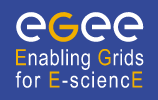
e-Science Points to Pollution Solutions
Results from a U.K. e-Science project are helping to solve two pressing environmental problems. One finding could help to avoid arsenic contamination of drinking water extracted from man-made wells. Another could lead to improved methods of removing the now-banned industrial chemical dioxin from soil. The results were obtained using e-Science techniques and Grid computing to simulate all the possible interactions between these contaminants and rock or soil.
Arsenic often appears in minerals rich in iron and sulphur, such as pyrite (fools’ gold). Scientists working as part of , a major project funded under the Natural Environment Research Council’s e-Science program, have found out precisely how arsenic is taken up and held in the pyrite structure and the factors likely to lead to its release. “We now know that arsenic replaces the sulphur in pyrite rather than the iron, and that pyrite is likely to dissolve more easily when arsenic is present,” says Dr. Kate Wright, who worked on the project. Further work could identify ways of stabilizing arsenic-containing iron sulphide rock by introducing additives that slow the rate at which it dissolves.
The eMinerals project found that a dioxin molecule will bind more strongly to clay surfaces the more chlorine atoms it contains, irrespective of the position of the chlorine atoms in the dioxin molecule. It also found that binding is stronger the greater the electrical charge on the surface. However, water competes with dioxin to bind to surfaces and, in practice, a dioxin molecule’s ability to bind to a surface is a balance between the binding strength of the dioxin to the surface, the water to the surface, and the dioxin to the water.
Both examples involved performing numerous simulations of the interactions between the different minerals in soil and rock with all the known variants of the contaminants. For example, there are 76 different variants of the dioxin molecule and numerous mineral surfaces in the environment to which they can attach, so hundreds of serious calculations are necessary.
The project has developed a Grid infrastructure consisting of clusters and condor pools (including campus Grids) at the collaborating institutions and resources held on the National Grid Service and the North West Grid. High-performance computing resources can also be accessed for particularly large simulations, if necessary.
Without access to such Grid resources, researchers would have to perform all of the simulations sequentially, taking too much time to be practicable. Using the eMinerals infrastructure, they can submit all these jobs at once and see the results within a few hours. Results are automatically returned to a distributed data store with an interface that shows the files as if they are part of a single system. The data can be accessed remotely by collaborating scientists, as well as by those who originally submitted the job.
Source: Research Councils UK
Latest News
The Call for Abstracts of the 3rd EGEE User Forum opened on 22 October 2007
... Read moreTechnical sites
Try the GRID
Become a User
Related Projects
Information Sheets
Contact EGEE
If you have questions about the Website contact: .

